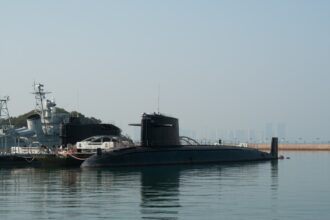Sonar technology, an acronym for Sound Navigation and Ranging, has revolutionized underwater exploration and military operations since its inception. This sophisticated system employs sound waves to detect and locate objects submerged in water, making it an invaluable tool for naval forces, marine researchers, and oceanographers alike. The fundamental principle behind sonar involves emitting sound pulses and analyzing the echoes that return after bouncing off objects.
This technology has evolved significantly over the years, transitioning from rudimentary systems used in World War I to advanced sonar arrays capable of providing detailed images of the underwater environment. The importance of sonar technology cannot be overstated, particularly in military applications where stealth and detection capabilities are paramount. Submarines, for instance, rely heavily on sonar for navigation and target acquisition while simultaneously striving to remain undetected.
As nations invest in advanced naval capabilities, understanding the intricacies of sonar technology becomes essential for both offensive and defensive strategies. The ongoing arms race in underwater warfare has led to innovations aimed at enhancing the stealth of submarines, ensuring they can operate effectively without being easily detected by enemy sonar systems.
Key Takeaways
- Sonar technology uses sound waves to detect objects underwater, making it crucial for submarine detection and stealth.
- Understanding the principles of sonar detection is essential for designing submarines that can evade detection.
- Making a submarine invisible to sonar poses significant challenges due to the need to minimize acoustic, magnetic, and hydrodynamic signatures.
- Material selection for submarine construction plays a critical role in reducing the reflection and absorption of sonar waves.
- Shape and design considerations for sonar stealth focus on minimizing the submarine’s acoustic and hydrodynamic signatures.
Understanding the Principles of Sonar Detection
At its core, sonar detection operates on the principles of sound wave propagation and reflection. When a sonar system emits a sound pulse, it travels through water until it encounters an object, such as a submarine or underwater terrain. Upon striking the object, the sound wave reflects back toward the source, where it is received by sensors that analyze the time it took for the echo to return.
This time delay allows operators to calculate the distance to the object, while variations in the frequency and amplitude of the returning sound waves can provide additional information about the object’s size, shape, and material composition. There are two primary types of sonar: active and passive. Active sonar involves emitting sound waves and listening for echoes, while passive sonar relies on detecting sounds emitted by other objects, such as submarines or marine life.
Each type has its advantages and limitations; active sonar can provide precise location data but risks revealing the user’s position, whereas passive sonar is stealthier but may not offer as much detail. Understanding these principles is crucial for developing effective countermeasures against sonar detection, particularly for submarines that must navigate hostile waters undetected.
Challenges of Making a Submarine Invisible to Sonar

Creating a submarine that is effectively invisible to sonar presents numerous challenges. One of the primary obstacles is the inherent nature of sound propagation in water. Sound travels faster and farther in water than in air, making it difficult to completely eliminate a submarine’s acoustic signature.
Even with advanced technologies designed to minimize noise and reflectivity, submarines will inevitably produce some level of sound that can be detected by sophisticated sonar systems. This reality necessitates a multifaceted approach to stealth that encompasses various design elements and operational strategies.
As advancements are made in sonar detection capabilities, submarines must continuously adapt to remain undetectable. This arms race between detection and stealth requires ongoing research and development efforts to identify new materials, designs, and technologies that can effectively counteract emerging sonar systems. The dynamic nature of underwater warfare means that what may be effective today could become obsolete tomorrow, making it imperative for naval forces to stay ahead of technological advancements in both sonar detection and submarine stealth.
Material Selection for Submarine Construction
| Material | Properties | Advantages | Disadvantages |
|---|---|---|---|
| Steel | High strength, good weldability | Durable, cost-effective | Prone to corrosion |
| Aluminum | Lightweight, corrosion-resistant | High strength-to-weight ratio | More expensive than steel |
| Titanium | High strength, corrosion-resistant | Lightweight, long lifespan | Very expensive |
The choice of materials used in submarine construction plays a critical role in determining its stealth capabilities. Traditional materials like steel are strong and durable but can produce significant acoustic signatures when subjected to sound waves. To mitigate this issue, modern submarines often utilize composite materials that are less reflective and absorb sound more effectively.
These materials can significantly reduce the amount of noise generated by the submarine’s hull as it moves through water, thereby enhancing its stealth profile. In addition to acoustic properties, material selection must also consider other factors such as weight, strength, and resistance to corrosion. Advanced polymers and specialized coatings are increasingly being employed to create hulls that not only minimize sonar detection but also withstand the harsh conditions of deep-sea environments.
The integration of these materials into submarine design represents a significant advancement in naval engineering, allowing for more effective stealth operations while maintaining structural integrity and performance.
Shape and Design Considerations for Sonar Stealth
The shape and design of a submarine are crucial elements in its ability to evade sonar detection. A streamlined hull reduces turbulence as the submarine moves through water, minimizing noise generated by hydrodynamic forces. Additionally, unconventional shapes that disrupt sound wave patterns can further enhance stealth capabilities.
For instance, some modern submarines feature non-linear hull designs that scatter incoming sonar waves rather than reflecting them directly back to their source. Moreover, internal design considerations also play a role in reducing acoustic signatures. By strategically placing machinery and equipment within the hull, designers can minimize vibrations that might otherwise be transmitted through the structure and into the surrounding water.
The careful arrangement of components not only aids in stealth but also contributes to overall operational efficiency, allowing submarines to maintain high levels of performance while remaining undetected.
Noise Reduction Techniques for Submarine Operation

Noise reduction is a critical aspect of submarine operations aimed at achieving stealth. Various techniques are employed to minimize sounds generated by machinery, propulsion systems, and even crew activities within the vessel. One common approach involves using quieter propulsion systems that produce less noise during operation.
Electric motors, for example, are often favored over traditional diesel engines due to their reduced acoustic output. In addition to propulsion noise, vibrations from onboard equipment can also contribute to a submarine’s acoustic signature. To combat this issue, submarines may incorporate vibration-damping materials and isolation mounts that absorb vibrations before they can propagate through the hull.
Furthermore, operational procedures are often designed to minimize noise during critical phases of a mission, such as when approaching enemy waters or conducting surveillance operations. By implementing these noise reduction techniques, submarines can enhance their stealth capabilities and increase their chances of remaining undetected.
Minimizing the Submarine’s Magnetic Signature
In addition to acoustic signatures, submarines must also contend with their magnetic signatures, which can be detected by advanced sonar systems equipped with magnetometers. A submarine’s magnetic field is influenced by its construction materials and onboard equipment, making it essential to implement strategies that minimize this signature. One effective method involves using non-magnetic materials in construction wherever possible, thereby reducing the overall magnetic field generated by the vessel.
Another approach is to employ degaussing systems that actively counteract a submarine’s magnetic signature by generating an opposing magnetic field. These systems can be particularly effective in neutralizing the magnetic signatures produced by ferromagnetic materials commonly used in submarine construction. By addressing both acoustic and magnetic signatures, submarines can significantly enhance their stealth capabilities and improve their chances of evading detection during critical missions.
Implementing Advanced Propulsion Systems
The propulsion system of a submarine is a key factor influencing its stealth capabilities. Traditional propulsion methods often generate significant noise that can be detected by enemy sonar systems; therefore, advancements in propulsion technology have become a focal point for enhancing stealth. One notable innovation is the development of air-independent propulsion (AIP) systems that allow submarines to operate silently without surfacing for extended periods.
AIP systems utilize various technologies such as fuel cells or Stirling engines to generate power without relying on atmospheric oxygen. This capability not only extends operational range but also reduces noise levels associated with traditional diesel engines. Additionally, electric propulsion systems have gained popularity due to their quiet operation and efficiency.
By implementing these advanced propulsion systems, submarines can maintain stealth while executing complex missions in hostile environments.
Utilizing Sonar Absorbing Coatings
Sonar absorbing coatings represent another innovative approach to enhancing submarine stealth capabilities. These specialized coatings are designed to absorb sound waves rather than reflect them back into the water column. By applying these coatings to the hull of a submarine, designers can significantly reduce its acoustic signature and make it more challenging for enemy sonar systems to detect.
The effectiveness of sonar absorbing coatings depends on their composition and application method. Researchers have developed various formulations that incorporate materials specifically engineered to dampen sound waves across different frequencies. The application process must also ensure uniform coverage over the hull surface to maximize effectiveness.
As research continues into new materials and technologies, the potential for further advancements in sonar absorbing coatings remains promising for future submarine designs.
Incorporating Acoustic Damping Technologies
Acoustic damping technologies play a vital role in minimizing noise generated by submarines during operation. These technologies encompass a range of solutions designed to absorb or dissipate sound energy produced by machinery and equipment onboard. For instance, specialized damping materials can be integrated into bulkheads and floors to reduce vibrations transmitted through the hull.
Additionally, advanced insulation techniques can be employed to isolate noisy components from sensitive areas within the submarine where crew members operate or where critical equipment is housed. By strategically implementing acoustic damping technologies throughout the vessel, designers can create an environment that minimizes noise generation while maximizing operational efficiency. This holistic approach not only enhances stealth capabilities but also contributes to crew comfort during extended missions.
Testing and Evaluation of Sonar Stealth Measures
The effectiveness of various sonar stealth measures must be rigorously tested and evaluated before deployment in operational environments. This process typically involves a combination of computer simulations, laboratory experiments, and field trials conducted under controlled conditions. By simulating different scenarios involving enemy sonar systems and environmental factors, researchers can assess how well specific design features or technologies perform in reducing acoustic signatures.
Field trials often involve deploying submarines in real-world conditions where they can be subjected to active sonar detection tests by friendly or neutral forces equipped with advanced sonar systems. These evaluations provide valuable data on how well various stealth measures hold up against actual detection attempts. Continuous testing and refinement are essential components of developing effective submarine designs capable of evading modern sonar technologies while ensuring mission success in increasingly complex underwater environments.
In conclusion, as naval warfare continues to evolve alongside advancements in sonar technology, submarines must adapt through innovative design strategies and operational practices aimed at enhancing stealth capabilities. From material selection and shape considerations to noise reduction techniques and advanced propulsion systems, each element plays a crucial role in minimizing detection risks during critical missions. The ongoing pursuit of effective countermeasures against sonar detection underscores the importance of research and development efforts within naval engineering as nations strive for superiority beneath the waves.
In the quest to make submarines invisible to sonar, researchers and engineers are constantly exploring innovative technologies and materials.
Another method focuses on altering the shape and design of the submarine to minimize noise and avoid detection. For those interested in a deeper dive into the science and technology behind these stealth techniques, an insightful article can be found on the topic at In The War Room. This resource provides a comprehensive overview of the latest advancements and challenges in submarine stealth technology.
WATCH THIS! America’s Nuclear Navy Was Born From Espionage
FAQs
What is sonar?
Sonar is a technique that uses sound propagation to navigate, communicate with or detect objects on or under the surface of the water.
How does sonar detect submarines?
Sonar detects submarines by emitting sound waves and then listening for the echoes that bounce off the submarine. The time it takes for the sound waves to return can determine the distance and direction of the submarine.
Why is it important for submarines to be invisible to sonar?
Submarines need to be invisible to sonar in order to avoid detection by enemy vessels and to carry out covert operations without being detected.
What are some techniques to make a submarine invisible to sonar?
Some techniques to make a submarine invisible to sonar include using sound-absorbing materials on the hull, designing the shape of the submarine to minimize sound reflection, and using quiet propulsion systems.
Are there any challenges in making a submarine invisible to sonar?
Yes, there are challenges in making a submarine invisible to sonar, as sonar technology continues to advance and become more sensitive. Additionally, the underwater environment can also affect the effectiveness of sonar invisibility techniques.




